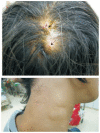First report of furuncular myiasis caused by the larva of botfly, Dermatobia hominis, in a Taiwanese traveler
- PMID: 23620844
- PMCID: PMC3631756
- DOI: 10.1016/S2221-1691(13)60056-8
First report of furuncular myiasis caused by the larva of botfly, Dermatobia hominis, in a Taiwanese traveler
Abstract
A case of furuncular myiasis was reported for the first time in a 29-year-old young Taiwanese traveler returning from an ecotourism in Peru. Furuncle-like lesions were observed on the top of his head and he complained of crawling sensations within his scalp. The invasive larva of botfly, Dermatobia hominis, was extruded from the furuncular lesion of the patient. Awareness of cutaneous myiasis for clinicians should be considered for a patient who has a furuncular lesion and has recently returned from a botfly-endemic area.
Keywords: Botfly; Furuncular myiasis; Taiwan; Traveler.
Conflict of interest statement
Figures


Similar articles
-
Furuncular Myiasis Caused by Dermatobia hominis in a Traveler Returning from the Amazon Jungle.Turkiye Parazitol Derg. 2017 Sep;41(3):173-176. doi: 10.5152/tpd.2017.4927. Turkiye Parazitol Derg. 2017. PMID: 29035248
-
Dermatobia hominis dermal myiasis. A furuncular lesion in a world traveler.Arch Dermatol. 1985 Sep;121(9):1195-6. Arch Dermatol. 1985. PMID: 4037848
-
Cutaneous myiasis from Dermatobia hominis.Wilderness Environ Med. 1997 Aug;8(3):156-60. doi: 10.1580/1080-6032(1997)008[0156:cmfdh]2.3.co;2. Wilderness Environ Med. 1997. PMID: 11990156
-
[Update on Dermatobia hominis: South American furuncular myiasis].Med Trop (Mars). 2008 Feb;68(1):7-10. Med Trop (Mars). 2008. PMID: 18478762 Review. French.
-
Furuncular myiasis caused by Dermatobia hominis, the human botfly.J Am Acad Dermatol. 2004 Feb;50(2 Suppl):S26-30. doi: 10.1016/s0190-9622(03)01488-9. J Am Acad Dermatol. 2004. PMID: 14726861 Review.
Cited by
-
The Botfly, A Tropical Menace: A Distinctive Myiasis Caused by Dermatobia hominis.Am J Clin Dermatol. 2021 Jan;22(1):81-88. doi: 10.1007/s40257-020-00522-2. Am J Clin Dermatol. 2021. PMID: 32797356 Review.
-
First record of Psorophora ferox (Diptera: Culicidae) infested with eggs of Dermatobia hominis (Diptera: Cuterebridae), in Ucayali: Peru.BMC Res Notes. 2024 Apr 2;17(1):98. doi: 10.1186/s13104-024-06759-y. BMC Res Notes. 2024. PMID: 38561830 Free PMC article.
-
Travel-Related Cutaneous Myiasis: A Case Report.J Clin Med. 2024 Sep 1;13(17):5190. doi: 10.3390/jcm13175190. J Clin Med. 2024. PMID: 39274403 Free PMC article.
References
-
- Robbins K, Khachemoune A. Cutaneous myiasis: a review of the common types of myiasis. Int J Dermatol. 2010;49:1092–1098. - PubMed
-
- Delshad E, Rubin AI, Almeida L, Niedt GW. Cuterebra cutaneous myiasis: case report and world literature review. Int J Dermatol. 2008;47:363–366. - PubMed
-
- McGraw TA, Turiansky GW. Cutaneous myiasis. J Am Acad Dermatol. 2008;58:907–926. - PubMed
-
- Marty FM, Whiteside KR. Myiasis due to Dermatobia hominis. N Engl J Med. 2005;352:23. - PubMed
-
- Plotinsky RN, Talbot EA, Davis H. Cuterebra cutaneous myiasis, new Hampshire, 2004. Am J Trop Med Hyg. 2007;76:596–597. - PubMed
Publication types
MeSH terms
Supplementary concepts
LinkOut - more resources
Full Text Sources
Other Literature Sources

